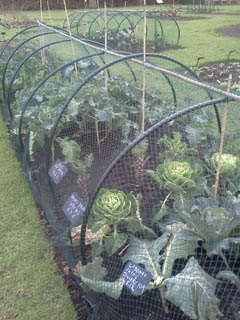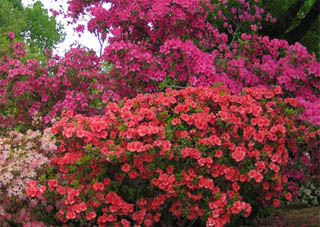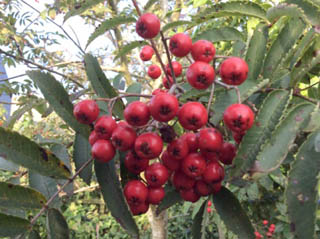 Well, it really is the season of mists and mellow fruitfulness now, and if you are early risers, as we are, you might be rewarded with the beautiful sight of mist floating above the ground, where the dew of the night meets the warmth coming off the still-warm soil. Quite a joy at this time of year.
Well, it really is the season of mists and mellow fruitfulness now, and if you are early risers, as we are, you might be rewarded with the beautiful sight of mist floating above the ground, where the dew of the night meets the warmth coming off the still-warm soil. Quite a joy at this time of year.
The vegetable patch is starting to yawn a little in some areas, asking if it can go to bed with a blanket of compost. The winter root vegetables are tantalising close to ready (go on, try a young parsnip; I have and they are yummy), the last runner beans are turning into leathery boomerangs, the winter kale and cabbages and brassicas are netted against the squadrons of pigeons and the last few tomatoes are ripening (try a banana in the bowl with them – the ethylene gas released aids ripening). Turnips, swede and kohl rabi are still growing, but generally we, gardens and gardeners alike, are ready for a bit of a rest.
And while the temptation might be to sit back on your laurels and congratulate yourself for a lovely harvest and summer display in your garden, it actually is the perfect time to start looking at what changes or additions you can make for this time next year. We all have our favourite season and colour schemes in the garden, but could it be a more all-year-round affair? Are there gaps in your late summer and autumn palettes that could be filled with some new additions? And what about winter? Our soil should stay warm well into October so it’s the perfect time to plant new shrubs and even some perennials, giving them time to establish some root growth before becoming dormant, and giving them a head start in the ground next year.
 In Cornwall, with our favourable climate and largely acid soils, the temptation is to have a blast in spring with camellias, azaleas, followed by some rhododendrons, and then to focus more on herbaceous in the summer. Nothing wrong with that, but you could be missing out on some wonderful autumn interest shrubs and trees that extend the colour in your garden. Leucothoe are a family of slow-growing, evergreen, acid-loving shrubs with the most beautiful red leaf coloration in the autumn. They keep a compact size, so won’t take over. Give them a semi-shaded to shady moist spot, and you won’t be disappointed. Pieris, which come in a wonderful range of colours, also require those conditions, and while they can get somewhat bigger, provide a real splash of colour, with small bell-like flowers following in the spring.
In Cornwall, with our favourable climate and largely acid soils, the temptation is to have a blast in spring with camellias, azaleas, followed by some rhododendrons, and then to focus more on herbaceous in the summer. Nothing wrong with that, but you could be missing out on some wonderful autumn interest shrubs and trees that extend the colour in your garden. Leucothoe are a family of slow-growing, evergreen, acid-loving shrubs with the most beautiful red leaf coloration in the autumn. They keep a compact size, so won’t take over. Give them a semi-shaded to shady moist spot, and you won’t be disappointed. Pieris, which come in a wonderful range of colours, also require those conditions, and while they can get somewhat bigger, provide a real splash of colour, with small bell-like flowers following in the spring.
Enjoying a similar setting, with shelter from strong winds is the Acer family – a guaranteed head turner in the autumn, with a myriad of colours and leaf shapes available. If you want to restrict their size, you can also keep them in pots as a real centrepiece, but as with everything in pots, remember to keep them well-watered. And don’t be put off by the fact they are deciduous. We find there are few greater joys as gardeners than seeing the first leaves breaking in the spring – it’s like seeing the plants again for the first time and a reminder that the changing seasons are good for us.
 On the herbaceous front, you can’t beat the late splash of colour that comes from the “prairie” plants, as they are fashionably known – Rudbeckia (shown here R. Goldsturm) , Helenium, Helianthemum and Echinacea, among others. Plant them now in very well drained soil (preferably with some grit mixed in the planting hole) and a sunny spot for a good display this time next year. And don’t forget a Sedum. They come in all sorts of lovely colours now, flower and foliage alike, and they are one of the most valuable food sources for our flying friends at this time of year. Watch a Sedum on a warm day, and it will have a coating of bees, butterflies, hover flies and moths – you name it.
On the herbaceous front, you can’t beat the late splash of colour that comes from the “prairie” plants, as they are fashionably known – Rudbeckia (shown here R. Goldsturm) , Helenium, Helianthemum and Echinacea, among others. Plant them now in very well drained soil (preferably with some grit mixed in the planting hole) and a sunny spot for a good display this time next year. And don’t forget a Sedum. They come in all sorts of lovely colours now, flower and foliage alike, and they are one of the most valuable food sources for our flying friends at this time of year. Watch a Sedum on a warm day, and it will have a coating of bees, butterflies, hover flies and moths – you name it.
One of our favourite late summer and autumn features are the berries and fruit. There are of course the edibles, such as blackberries, apples and pears, but there are also the ornamentals. This is the time of year that Malus (crab apples ), Sorbus (mountain ash), Pyracantha and Cotoneaster (trees and prostrate shrubs alike) , among others, come into their own. Crab apples provide that crossover into edibles – you can make a jelly from the fruit if you want, but if not, just admire, and know that you are also providing food for the wildlife. Crab apples come in many varieties, with varying leaf and fruit colour – purple, pink, red, yellowy, you choose. They are very undemanding, and if on dwarf rootstock, are suitable even for the smallest gardens. This one is, rather appropriately, Malus Gorgeous, on standard bush rootstock, which I hope will grow into a rather marvellous tree quite soon!
 Sorbus are also very versatile. Don’t eat these berries though; leave them for the blackbirds, which trust us, will have a good meal. The native Sorbus has the brilliant scarlet berries we are all familiar with (and yes, that really is blue sky in the background) but again, there are many varieties with a
Sorbus are also very versatile. Don’t eat these berries though; leave them for the blackbirds, which trust us, will have a good meal. The native Sorbus has the brilliant scarlet berries we are all familiar with (and yes, that really is blue sky in the background) but again, there are many varieties with a
wide range of colours – S. Joseph Rock has a lovely yellow berry, and S. Pink Pagoda a vibrant pink, as the name suggests. Don’t forget hawthorns (Crataegus) too, for autumn berry interest. A hedgerow staple in its native form, but many varieties exist, with excitingly coloured flowers in the spring, followed by autumn berries.
And so, on to things you can plant now ready to close the winter gaps. Yes, amazingly, there is a lot out there that can provide you with colour and scent over the winter. Try an unusual clematis, C. napaulensis, for winter scent. It’s a rather disconcerting clematis as it drops all its leaves very suddenly in late summer, only to resprout leaves and cream and pink bell-shaped flowers over the winter. It provides a glorious scent and a generous food source for those bees still out and about. Definitely recommended for those beekeepers out there, along with the winter-flowering heathers.
 Consider also the Skimmia family for winter interest; again an evergreen, acid soil and shade lover. Skimmia are mostly dioecious, which means there are distinct male and female varieties, although there is one hermaphrodite variety (S. Reevesiana) which can service itself, so to speak (ahem). So, make sure you know which one you have, or you might be disappointed! The male varieties produce flowers, but no berries. The female will produce flowers and berries, but only if there is a male plant nearby. It doesn’t necessarily have to be in your garden (your plant could be a floozy and commune with one in your neighbour’s garden), but will need that reasonably close contact. Most Skimmia have white or pinkish lightly scented flowers in summer, and red berries, but for something a bit different, look out for S. Kew Green (male) and S. Kew White (female). As its name suggests, Kew Green has green-tinged flowers, as does Kew White, but the female also has striking white berries in winter and spring. A real eye-catcher.
Consider also the Skimmia family for winter interest; again an evergreen, acid soil and shade lover. Skimmia are mostly dioecious, which means there are distinct male and female varieties, although there is one hermaphrodite variety (S. Reevesiana) which can service itself, so to speak (ahem). So, make sure you know which one you have, or you might be disappointed! The male varieties produce flowers, but no berries. The female will produce flowers and berries, but only if there is a male plant nearby. It doesn’t necessarily have to be in your garden (your plant could be a floozy and commune with one in your neighbour’s garden), but will need that reasonably close contact. Most Skimmia have white or pinkish lightly scented flowers in summer, and red berries, but for something a bit different, look out for S. Kew Green (male) and S. Kew White (female). As its name suggests, Kew Green has green-tinged flowers, as does Kew White, but the female also has striking white berries in winter and spring. A real eye-catcher.
And scent. Not the prettiest of shrubs, with tiny white or yellow/white flowers, but Lonicera fragrantissma and L. x purpusii Winter Beauty (both called Winter honeysuckle) earn their keep for their scent alone. Plant them close to where you walk in the winter months – next to a path or gate, and enjoy the wafts.
Sarcococca (Winter box) is another not terribly striking plant, although it does have a lovely glossy evergreen leaf. An acid soil and shade lover again, the scent travels yards in the winter, tickling those nostrils as you scuttle from house to car and reminding you that it is still nice to be in the open air, even in winter. Similarly, the Daphne odora range cannot be beaten for late winter/early spring scent, and the variegated version (D. odora Aureomarginata) provides an extra splash of colour with its gold-edged leaf.
 And while we’re at it, it is a perfect time to make lasagne, except this time, not with Bolognese sauce, béchamel and pasta, but with spring bulbs! Lasagne planting is the mouth-watering name given to layered bulb planting in pots. Start with some crocks for drainage, and then add a layer of compost. After that, make layers of bulbs and compost, starting with your tallest and biggest bulbs at the bottom of the pot, and layering up to your smallest and shortest bulb. That way, you will have a succession of colour and heights in your spring pots. Daffodils and many other spring bulbs are available about now, but hold off on tulip planting. Tulip bulbs need to go into colder soil to avoid succumbing to tulip fire, so leave them until November. It is fine to leave your pots outside when planted up, but keep an eye out for extremely wet weather and protect them if it looks like they might sit too wet.
And while we’re at it, it is a perfect time to make lasagne, except this time, not with Bolognese sauce, béchamel and pasta, but with spring bulbs! Lasagne planting is the mouth-watering name given to layered bulb planting in pots. Start with some crocks for drainage, and then add a layer of compost. After that, make layers of bulbs and compost, starting with your tallest and biggest bulbs at the bottom of the pot, and layering up to your smallest and shortest bulb. That way, you will have a succession of colour and heights in your spring pots. Daffodils and many other spring bulbs are available about now, but hold off on tulip planting. Tulip bulbs need to go into colder soil to avoid succumbing to tulip fire, so leave them until November. It is fine to leave your pots outside when planted up, but keep an eye out for extremely wet weather and protect them if it looks like they might sit too wet.
So, although it is also time for a bit of a tidy up in the garden, cutting back some of those untidy perennials to reduce the potential for disease and a haven for the beastlier garden pests, reward yourself with some time to think of more pleasant things – potential new plants that might extend and add to your garden’s interest. But if you want to plant something soon, don’t leave it too much longer, or the plants will be going to sleep and will not appreciate going into cold soil. Imagine being plucked out of bed in your PJs and told to stand outside. No, not nice.
And if you don’t have the time or energy left to start planting now, do remember that Christmas isn’t so far away. Put a garden centre voucher on your present list and you’ll be ready to get going as soon as spring arrives!
[On a final note, it would be remiss of us not to end this first column without acknowledging the wonderful job Nicola Bush has done in writing such an informative, educational and humorous column for the last several years, and without saying a massive thank you to her on behalf of all RO readers. Nicola, you have left us massive wellies to fill, and we only hope we can measure up. Enjoy the extra free time – and spend it in the garden, of course! ]
Sarah Daniel and Helen Robins, Pengelly Garden Centre

